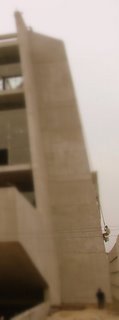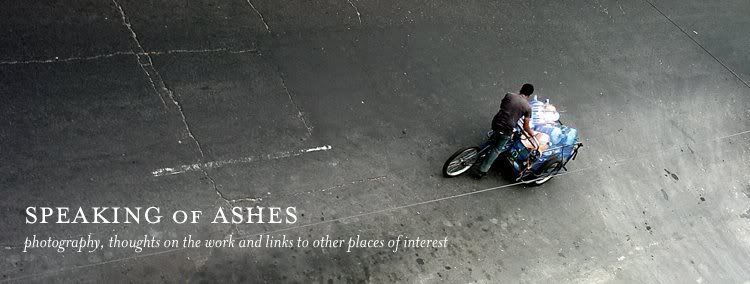on fixation
 Below is the longer version of an essay I wrote for the March/April issue of ArtSeen Magazine. It's in print-edition only. I think you can get it on better (artsy) newstands in NYC and in London and Italy (I assume other parts of Europe too).
Below is the longer version of an essay I wrote for the March/April issue of ArtSeen Magazine. It's in print-edition only. I think you can get it on better (artsy) newstands in NYC and in London and Italy (I assume other parts of Europe too).
One of the things I am constantly fixated upon is a particular angle. I see it clearly in colonial buildings where they are buttressed and sometimes where, after some hundreds of years, they have settled into ground that is ever uncertain. The angle appears again in a train station being built not far from my house with concrete that imitates nothing but a smog filled sky. Here the buttresses are so enormous as to make the angle almost invisible but from a distance. I have used its one note iconography to describe airplanes and religious figures and I have used it to prop up things that would other wise fall. It is always an illustration, though I dislike illustration, it insists that I can only partially describe it. I have no idea where it came from. I believe if I grabbed hold of it, like a Carlos Castaneda figment, it would whirl me to some other location and I would probably be numb for days, if my heart survived the shock. It betrays some kind of movement, but it never moves. It is always a part of something stationary though it appears as though it is moving. I can easily associate it with different parts of my body and I believe it thinks a little bit in those parts of me, when I allow it. I try to always allow this angle to be thinking, but right now, when I am writing, it is quiet. It may even be tense.
A friend of mine who’s been typing away at a writing program asked me to put down a few words about motivation and fixation. We were talking, of course about the problems of art schools, and being stuck in programs that insist on their own inadequacy. What follows is based on my letter to him, on how artists might use obsessive tendencies and fixations that they already possess to try to inform their work, keep it moving and to make the work a little easier by making it part of what we are doing all the time anyway. When I try to talk about the angle, then I begin to realize that it is a language unto itself and it doesn’t like being translated because it isn’t pure at all.
The angle has a thousand associations and none of them is clean, many of them are cheap. None of them is without sin. The most important sin to allow in your fixation is promiscuity. Your fixation should couple with its opposites and its family and your family. It should move in and out of every association, tell you each time about the other thing, the association and if you force it to, it will trick you into believing that it is worth pursuing. A fixation never tells you about itself. If it does, and it will, it is lying. A false fixation is as good as a true one.
Calling this thing an “angle” is not honest. The word leads one to believe it is somehow a geometrical abstraction, an ideal. It is not really a posture either, though I have used it that way more than perhaps every other connotation of the word. When you find the right thing, then of course you see it everywhere. Finding what fixates you of course is going to require you to see it all the time. I see it in stooped figures of whose remarkable lives I know nothing. It isn’t supernatural. It isn’t un-real. It requires not one ounce of faith, because it is always something else anyway, and it mocks me for writing even this sketch of it.
And why should it come up now, in these pages when so many other pressing issues of importance are out there clamoring for our attention. There are many good reasons why you don’t learn much about fixation, about epistemology, in the institutions we’ve inherited from the past. They are largely forbidden from entering into your psyche and we can be grateful for that. Institutions are challenged with protecting and upholding the order that we see crumbling around us. The people in these institutions no longer believe in the modernist notion of the object of our study being 100% separate from us, languishing out there in the cold scientific laboratory. Certainly they are being paid to maintain the biologists strict scientism, and they’re economics departments depend on the forever expansion of gross national product, and they must do this while they teach us, with a smirk, that the arts are on the “entertainment” side of higher education. The collapse we are witnessing is in line with the truth that we understand and that institutions must by their nature deny. The Fordist model of education is not going to go away any more than will the Cartesian model from which it sprung. It is just as when I spot the angle leering at me from the new train station that I realize, of course, the station still requires an incentive to be built in the first place, moving people, easing traffic.
We are challenged with thinking in spite of these older models and one good teacher or good thought has been enough, at enough times in history that we shouldn’t be too discouraged. I am hoping you have something in mind already. Perhaps it is an actual object, a memory or idea of some event that involved such an object. Perhaps it is only that when ever you draw something, it always ends up being the same thing. Fixations like to present themselves as mistakes, or as errors. Certainly they show up as obstacles more often than they show up as facilitators. That is why we spend so much time fixating on all the problems associated with making art rather than actually making it. All of those fixations are the same thing. I believe my angle is deeply aligned with a sense of frustration, perhaps my initial frustration. Frustrations are less artful ways of describing fixations. I am hoping you can squint a little bit and not take things at all seriously, and watch for the things that are watching you. These should scare the hell out of you. That is what having an interest involves of course. One does not learn to make art from art any more than an astronomer aims a telescope at a map of the sky. Therefore an art school without a serious nature program is a bit like a secular seminary or an observatory built inside of an atrium. I can condemn these things but they won’t go away any more than will my fixation, our frustration.
In very simple terms what we are doing when we work this way is we are trying to sublimate the ego-thinking that normally accompanies our everyday lives, and we are trying to think even for a few moments, mimetically, or as the object we’re observing might itself think. It sounds quite simple, in fact it is simple, but it is not something that everyone can do easily. It does require relaxation and suspending our everyday thinking. There are probably countless other methods and tools that artists can find to try to achieve this. But most important is to understand that there is an ecology to your doing this. Thinking happens in the completion of a circuit. That is to say that the thing is there outside of you, your working with it adds another unit, point to point and the two together amounts to the thought. And all of these circuits happen as parts, arcs, circles, within larger systems.[i] The thought is not going to exist solely in your head but requires the fixated object to become a thought.
But all of this is a way saying that in fact a good deal of how the present imagines itself is utterly, contemptibly wrong. Writing around, or painting around your fixation is a tremendous blow to the giants including the art-world and literary giants not even to mention those others. This of course explains the vigorous and venomous attacks on sensuality. Of course the sublimation of sensuality has always been what has enabled the nightmare version of “progress” that we are seeing now. I am asking you to commit a very sensuous thought-crime and you must be vigilant in committing it regularly and in aiming for hard results. Working with a fixation requires your totality, not in a way that should exhaust you but in a way that allows more of your totality to speak. It is that totality to which people, audiences, consumers, respond, and to which your most modest success must be devoted.
[i] This essay is indebted to Berman, Morris. 1981 (1984). The reenchantment of the world.


No comments:
Post a Comment